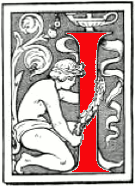The following paragraphs come from the Preface to Literary Appropriations of Myth and Legend in the poetry of Alfred Lord Tennyson, William Morris, Algernon Charles Swinburne and William Butler Yeats, by Ewa Młynarczyk (1982-2022). See bibliography for details. This was written as a doctoral thesis for the Institute of English Studies, University of Warsaw, but, very sadly, Ewa died before she was able to defend it. Her supervisor, Professor Grażyna Bystydzieńska, having given it a final edit, the institute has now made it available as a book. The proceeds of the paperback edition will – in accordance with the wish of Ewa's parents – support the Avalon Foundation in Warsaw, which helps people with disabilities. A free electronic version can also be downloaded (click on the title in the bibliography). — Links and illustration added, and footnotes incorporated, by JB

n the nineteenth century, the comparative approach [to mythology] was employed. by two rivalling schools of thought at Oxford University — Friedrich Max Müller’s comparative philology and Andrew Lang’s comparative anthropology. Müller posited the theory that Greek mythology was in fact a “disease of language” (1873, 12), that is, what was originally a metaphorical description of the natural phenomena was later misinterpreted as stories about gods and heroes. Even though the old Aryan language of mythology had been forgotten, the true meaning of myths could still be decoded by means of analysing the roots of Greek mythological names and comparing them to the names of gods and heroes in the Indian Vedas. Müller’s studies led him to the conclusion that the main Greek myths were in fact different stories about the sun-god chasing the dawn and conquering the darkness. Although Müller’s concept of the solar myth underlying many hero myths enjoyed huge popularity, it also met with severe criticism already in his own time....
By the mid-nineteenth century, comparative mythology had become such a fashionable trend that a figure of a serious scholar-mythologist even made an appearance in one of the most important novels of the nineteenth century, George Eliot’s Middlemarch (1871-72). One of its main characters, the Reverend Edward Casaubon, devotes all his time to his research aimed at discovering the Key to all Mythologies. This is how he expounds the nature of his studies to Dorothea:
For he had been as instructive as Milton’s “affable archangel”; and with something of the archangelic manner he told her how he had undertaken to show (what indeed had been attempted before, but not with that thoroughness, justice of comparison, and effectiveness of arrangement at which Mr. Casaubon aimed) that all the mythical systems or erratic mythical fragments in the world were corruptions of a tradition originally revealed. Having once mastered the true position and taken a firm footing there, the vast field of mythical constructions became intelligible, nay, luminous with the reflected light of correspondences. But to gather in this great harvest of truth was no light or speedy work. His notes already made a formidable range of volumes, but the crowning task would be to condense these voluminous still-accumulating results and bring them, like the earlier vintage of Hippocratic books, to fit a little shelf. [19]

The wording in this passage suggests that Mr. Casaubon may be read as a generic embodiment of the eighteenth- and nineteenth-century scholars. His notion that “all the mythical systems or erratic mythical fragments in the world were corruptions of a tradition originally re-vealed” brings to mind the attempts of the eighteenth-century syncretists to expose the Revelation underlying various religious systems, which is to be finally made “luminous with the reflected light of correspondences.” Yet, this metaphor of light is put to ironic use later in the novel, as the narrator observes in chapter 20 that Mr. Casaubon was so absorbed in his research, which eventually proved futile, that “With his taper stuck before him he forgot the absence of windows, and in bitter manuscript remarks on other men’s notions about the solar deities, he had become indifferent to the sunlight” (181). This allusion to the solar myth may also imply that he is supposed to be a fictional counterpart of Müller. [Młynarczyk 17-21]
Links to Related Material
- Myth and Legend in Victorian Literature (from the Preface)
- William Morris amd the Old North Legends (from the Introduction)
Bibliography
Eliot, George. Middlemarch. New York, Toronto: Bantam Books, 1985.
Młynarczyk, Ewa. hereLiterary Appropriations of Myth and Legend in the poetry of Alfred Lord Tennyson, William Morris, Algernon Charles Swinburne and William Butler Yeats. Warsaw: Institute of English Studies, University of Warsaw, 2024.
Created 14 January 2024